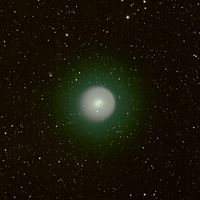- Coma (cometary)
-
 The comet Ikeya-Zhang exhibiting a bright, condensed coma (March 2002)
The comet Ikeya-Zhang exhibiting a bright, condensed coma (March 2002)In astronomy, a coma (from the Greek κόμη, "hair") is the nebulous envelope around the nucleus of a comet. It is formed when the comet passes close to the Sun on its highly elliptical orbit; as the comet warms, parts of it sublimate.[1] This gives a comet a "fuzzy" appearance when viewed in telescopes and distinguishes it from stars.
The coma is generally made of ice and dust.[1] Water dominates up to 90% of the volatiles that outflow from the nucleus when the comet is within 3-4 AU of the Sun.[1] The H2O parent molecule is destroyed primarily through photodissociation and to a much smaller extent photoionization.[1] The solar wind plays a minor role in the destruction of water compared to photochemistry.[1] Larger dust particles are left along the comet's orbital path while smaller particles are pushed away from the Sun into the comet's tail by light pressure.
 Comet 17P/Holmes, 2007/11/02
Comet 17P/Holmes, 2007/11/02
About a month after an outburst in October 2007, comet 17P/Holmes briefly had a tenuous dust atmosphere larger than the Sun.[2] The Great Comet of 1811 also had a coma roughly the diameter of the Sun.[3] Even though the coma can become quite large, its size can actually decrease about the time it crosses the orbit of Mars around 1.5 AU from the Sun.[3] At this distance the solar wind becomes strong enough to blow the gas and dust away from the coma, enlarging the tail.[3]
Stardust was a NASA mission to recover samples of a comet's coma.
In some cases, such as the Great Comet of 1882, a comet develops a visible antitail or dust tail, which points in a different direction and when the viewing angle and parallax are just right may appear to point in the opposite direction from the normal ion tail.
See also
References
- ^ a b c d e Combi, Michael R.; Harris, W. M.; Smyth, W. H. (2004). "Gas Dynamics and Kinetics in the Cometary Coma: Theory and Observations". Lunar and Planetary Institute (Comets II) 745: 523–552. Bibcode 2004come.book..523C. http://www.lpi.usra.edu/books/CometsII/7023.pdf.
- ^ Jewitt, David (2007-11-09). "Comet Holmes Bigger Than The Sun". Institute for Astronomy at the University of Hawaii. http://www2.ess.ucla.edu/~jewitt/holmes.html. Retrieved 2007-11-17.
- ^ a b c Gary W. Kronk. "The Comet Primer". Cometography.com. http://cometography.com/educate/comintro.html. Retrieved 2011-04-05.
Comets Features Nucleus · Coma · Tails · Antitail · Dust trail

Types Extinct · Lost · Great · Main-belt · Sungrazing (Kreutz Sungrazers) · Interstellar
Lists See also Atmospheres Major 
Tenuous See also - Stellar atmosphere
- Coma (cometary)
- Extraterrestrial atmospheres
Categories:- Comets
- Comet stubs
Wikimedia Foundation. 2010.
